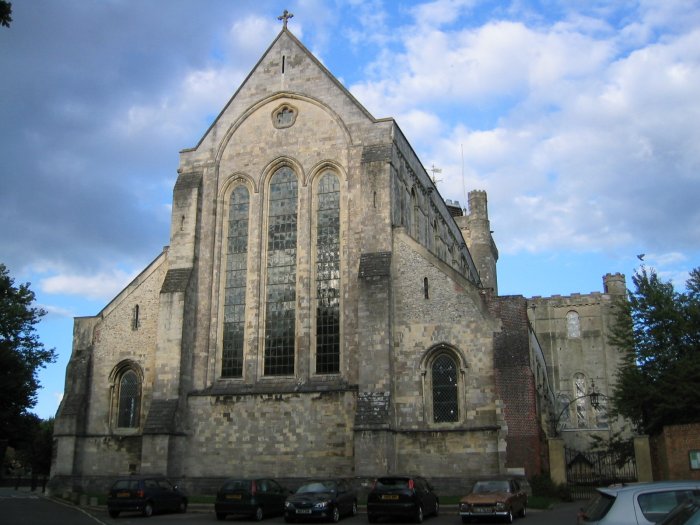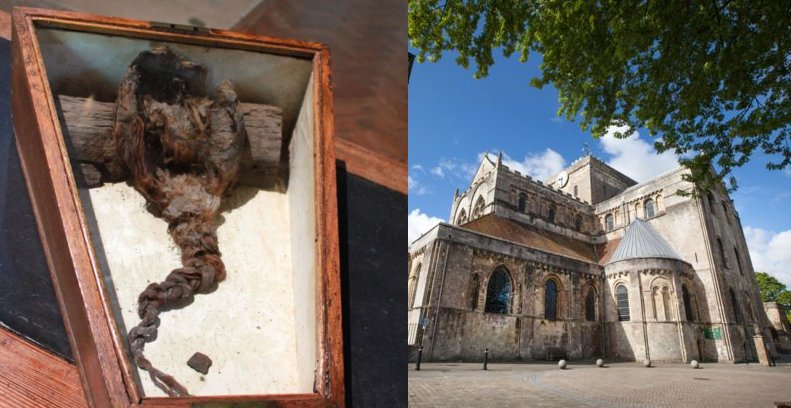MessageToEagle.com – The story started many years ago, back in October 1839, when a group of gravediggers discovered an ancient coffin containing human hair.
Many years later, in 2000 a seven-year-old boy called Jamie Cameron went on a school trip to his local parish church, Romsey Abbey in Hampshire. There he was taken to a display case and was immediately drawn to the full head of hair, which was still resting on the oak “pillow” on which it was found.
The interesting exhibit helped persuade that school boy to pursue a career in archaeology and today he is an archeologist who is trying to find an answer to unravel the mystery of the human hair found in the ancient coffin in Romsey Abbey.
There Is Hair – But The Skull Is Missing
What is unusual about this particular archaeological discovery is that the hair is shaped as if it is still sitting on a head but there is no skull. According to the archaeologists, the white bits – visible in the photos – are the remains of the scalp. There is even a plait which is several inches long.
According to some historians, the abbey where the coffin was found is probably dated back to Saxon times. There are also those who think it might have been Roman.

Over the years, there have been theories about who the hair might have belonged to but nothing more than that. Frank Green, who is the archaeological adviser to Romsey Abbey thinks it was a person of some significant status because there was originally an outer wooden coffin and an inner wooden coffin inside the lead one.
Did The Hair Belong To A Saint?
Over the years there has been speculation that it was the hair of a saint.
“The two saints are St Morwenna who was the first abbess here and St Ethelflaeda, who is our patron saint,” Romsey’s vicar, Reverend Canon Tim Sledge, explains.
“And I think that’s the rather romantic, hopeful, aspirational thing about this. These two saints are unique to Romsey – no one else has ever heard of them. They are our two saintly celebrities.”
Scientific Tests Can Solve This Ancient Mystery
Jamie Cameron decided to conduct tests hoping to learn more about the identity of the person whose hair was found inside the coffin. The results were intriguing to say the least.
Radio carbon tests were carried out to fins out when the person lived and the results suggest something in the mid to late Saxon era. The results showed that the person almost certainly died sometime between the years 895 and 1123. To be slightly more specific, there is a 68.2% probability that the death occurred between 965 and 1045.
The tests also revealed what this person might have eaten.
“We managed to find signals which are indicative of marine protein, so fish,” says Cameron.
And then there was the pine resin. “We can’t tell whether that was something to do with the funerary ritual or hair care during life.”
The crucial question though is whether this scientific analysis has brought us closer to knowing who it was who was buried in that lead coffin. The abbey’s archaeological adviser, Frank Green, thinks it has.
See also:
Why We Celebrate Saint Lucy’s Day – The Bringer Of Light And Patron Of The Blind
“The fact that this person had a marine diet could be very specific to perhaps members of the monastic community.
“And the context of the burial in what would have been the south transept of the previous building right against the abbesses’ doorway, strongly suggests it’s someone linked to the monastic community.”
However, archaeologists still do not know whether this ancient hair belonged to a woman or man.
Future DNA analysis can shed more light on the person’s identity and scientists will hopefully be able to solve this ancient mystery.
MessageToEagle.com







